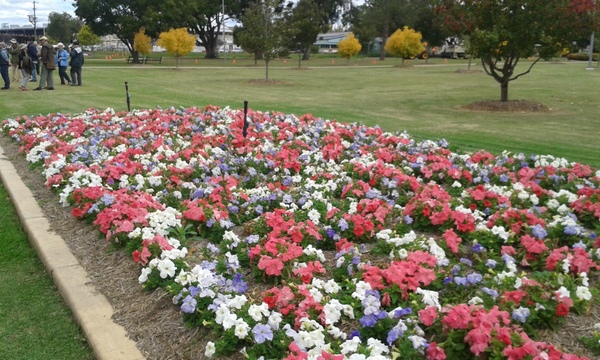No-one could help but notice the eye-catching displays of colourful petunias in the roundabouts in Palmerin Street. What wonderful, hardy and versatile flowers they are.
They will grow in almost any position but obviously will do best in good quality, free draining, fertile soil in full sun and will flower prolifically for months.
The colour choices in the roundabouts look very pretty and brighten the streets. The massed beds in Leslie Park are also looking good.
Petunias are native to South America and are closely related to tobacco, tomatoes, potatoes, cape gooseberries, deadly nightshade and chilli peppers.
The name comes from petun a Tupian Indian word for tobacco. Some types have been reclassified recently as Calibrachoa and these are what we now know as “million bells” because of their smaller prolific flowers and sprawling, low growing habit.
Petunias are actually a perennial, but as they do not tolerate frosts, they are usually treated as an annual and planted in spring.
They will continue to flower right through summer and autumn with care and frequent dead heading to keep them compact.
They do like a fare amount of watering but are amazing tolerant of dry conditions when established.
Too much heavy rain or overhead watering will spoil the flowers so a gentle spray is best. However they will recover quickly from water damage and soon be covered in a riot of colour again.
While most are bred to be compact, erect, showy mounds of flowers there are some sprawling patio varieties that are ideal for hanging baskets or pots.
The colour range seems endless and each year new colours become available in single or doubles, solid colours, speckled or veined.
So just about any colour combination you desire can be planted out to provide a lasting, stunning effect and, depending on how advanced the seedlings you choose, will be flowering well after about six weeks from transplanting.
They can be transplanted from the three leaf stage and should be planted about 20cm apart.
My broad beans are growing nicely and already flowering. It must be the weather because I didn’t expect to see flowers until spring. It will be interesting to see if they set beans.
If I had the garden space I would plant some more as I have just realised they come in different coloured flowers and would like some red flowered ones just for variety. Broad beans are also known as Fava beans and grown broad acre for commercial use.
Like all legumes, with the aid of bacteria, they are able to convert nitrogen from the air to a form that can be used by other plants, so, after they have finished bearing cut them down, pull them up and dig them into the bed as a green manure crop.
Some trivia for this week:
* Bristlecone pines are the oldest living and growing tree and are found in Utah, Nevada and eastern California.
* Bamboo is the fastest growing woody plant in the world. Some varieties can grow 35 inches in a day.
* There is archaeological evidence that grapes were grown to make wine over 8000 years ago in the region that is now Iraq. However the Egyptians were the first to record the wine making process about 5000 years ago.
Peanuts are not nuts but legumes and related to beans and lentils. They contain more protein, niacin, folate and phytosterols than any nut.
* Dragonflies can fly up to 20 miles an hour, hover and fly backwards. They are insect devouring predators and as such are a welcome sight in any garden.
* The average caterpillar has 4000 muscles and 248 in its head alone.
* Egyptian labourers are reputed to have eaten onions to give them strength while building the pyramids.
Don’t forget the horticultural society’s trip to the Queensland Garden Expo in Nambour on 8 July for a great day out. Tickets are available from Danny Lyons and include the bus trip, home-made morning tea and entry to the expo.
Get the latest news to your email inbox FREE!
REGISTER






